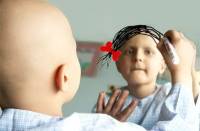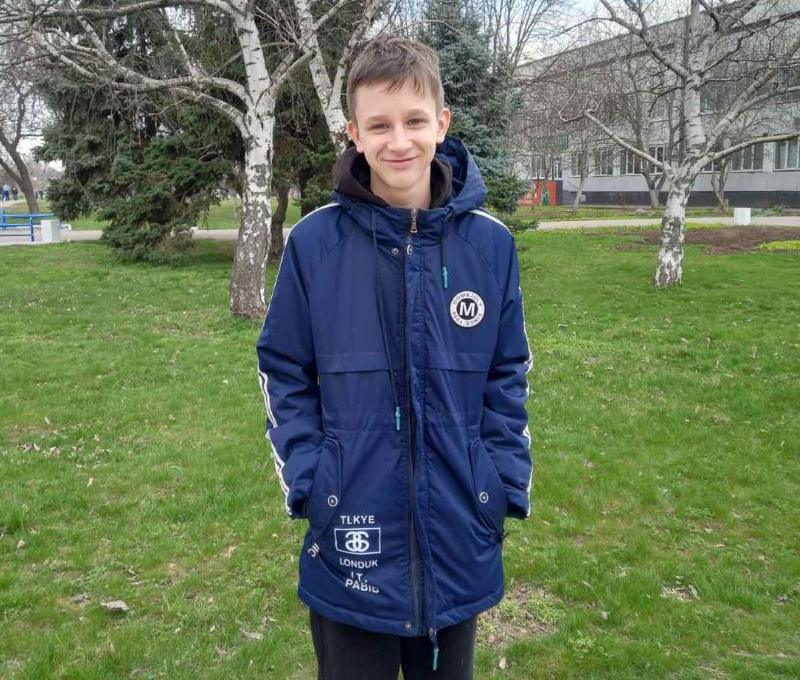
Landscape at the entrance to Kalinovka

The very same landscape as seen in the painting of an old, unknown artist. [Note by translator: Kalinovka is the former Mennonite agricultural estate Steinbach, created in the 1830s by German-Mennonite settler Klaas Wiens. The bridge across the Chukrak creek is a beloved image for us the descendants.]
[Note by translator: Photographs of this beautiful building, formerly the Jacob and Marie Schmidt Dick residence, appear in most books of historical Russian-Mennonite buildings.]
On Friday, 21 September 2007, we once again visited the facility for children with neurological-physical disabilities in Kalinovka, Chernigov Raion, Zaporozhye Oblast. Tatiana from Kiev, together with her friends, donated a large quantity of toys, diapers, and other useful items for the children’s home. Also participating on the trip were: volunteer Sveta Krilova, pediatrician Mariana, volunteer Volodya, and the writer of these lines. To our surprise, by some miracle, they successfully crammed all of the gifts and Pampers into Volodya’s car.


Volodya’s auto with everything crammed inside
Two-and-a-half hours after departure from Zaporozhye on a frightfully potholed road, we pulled up in Kalinovka. We hand over and photograph the gifts for the [follow-up] report. The appearance of the building for the girls pleases us, the repair of which will be completed in the course of the next month. Until the end of the remodeling, all of the girls live in the summer barracks, which gets extremely cold at night.
As we distribute the gifts to the patients of the children’s home, the bleak reality of Kalinovka gradually sinks in. Around thirty girls of various ages (from four to twenty-five) live in one place. The number of nurses’ aides is obviously not enough to guarantee normal care, quite apart from the care appropriate for the [disabled] children.
[Note by translator: Many of the girls at Kalinovka-Steinbach have Down syndrome, a genetic condition that carries a variety of health problems. “The most common manifestations of Down syndrome are the characteristic facial features, cognitive impairment, congenital heart disease (typically a ventricular septal defect), hearing deficits (maybe due to sensory-neural factors, or chronic serous otitis media, also known as Glue-ear), short stature, thyroid disorders, and Alzheimer's disease. Other less common serious illnesses include leukemia, immune deficiencies, and epilepsy” (Wikipedia, http://en.wikipedia.org/wiki/Down_syndrome).]

Gifts from Tatiana from Kiev and her friends

: two of the four wheeled platforms also brought by Tatiana from Kiev and purchased by ___ “Komora-S.”





Girls’ pavilion
We go into the building for the non-ambulant (bedfast) children and distribute gifts there. Dr. Mariana, together with a nurse, examines several children, taking notes on a notepad. What Mariana has to report, to put it mildly, is not encouraging. Among a large number of children, we observe symptoms of hypotrophy [atrophy or slackness of muscles resulting from neurological defects or disease and/or malnutrition]. Among several children, hypotrophy is present to a profound degree. The reason is not that there is too little nourishment for the children. Rather, the reason is that it is impossible for the children to take in and digest food in view of the type of diet and feeding practices they receive. One aide must feed thirteen to seventeen children at a feeding. Taking into account the severity of the disabilities and diseases, properly to feed a [large] number of patients is far from easy. For several children there may be problems with chewing and swallowing; or food is received but not digested with the result that children become weak, those who can move, crawl with [greater] difficulty, and those who once crawled stop moving altogether.
For all practical purposes the children are not examined after the moment the first diagnosis is made. Because of that they almost never receive adequate treatment for their disabilities and illnesses. After all, the pediatrician arrives from the raion center Chernigovka only once a week. It is clear that during only one visit it is practically impossible to provide skilled care to such a [large] number of patients. Several children receive medications prescribed a long time earlier. Such a situation is intolerable, since most medications have an expiration date for use, which, if exceeded, can have possible negative consequences.
In Dr. Mariana’s opinion, all of the children absolutely must undergo an Echo EG (echoencephalography or ultrasound of brain), cardiogram, ultrasound of internal organs, and examination by a neurologist, psychiatrist, cardiologist, and ophthalmologist. A [Social Protection] orphanage for neurologically and cognitively disabled children ought to have a neurologist and psychiatrist on its own staff, but, unfortunately, there is no one who wishes to work in such a post (and simply put, salaries for such specialists are not provided for).
Children lie in their beds for days on end, and no one receives massage, mandatory in such cases. The consequence: bedsores and further deterioration of motor function. They may not carry the children outside for YEARS!!! The result: anemia and a bunch of related medical problems. Any medical student knows that children must be in the fresh air several times a day. But this rule does not apply to the children at Kalinovka. Taking into account the serious extent of their disabilities, it is not surprising that around 10% of the children die annually. For example, one of the children died from cachexia [wasting away of muscles and weight as in the last stages of cancer], for others, edema of the brain, and so forth.
I am visiting the ward for bedridden children [located on second floor of Jacob Dick “barn”] for the third time this year, and each time it is a depressing sight. I understand that it is too much for modern science to defeat many of the enemies [figurative] of these children. But do we all believe that our society cannot provide a worthwhile life for those children, innocent as they are of such fates? I can’t believe that it is impossible to get rid of the flies that sit on the children’s faces. I can’t believe that it is not possible to organize outings for the children into the fresh air. I refuse to accept that we are not able to provide proper nutrition and adequate medical treatment for these children. I know prominent companies and state agencies where thousands of people find it hard to keep busy during the work day. And there [at Kalinovka] one aide runs ragged trying to feed and take care of seventeen patients. For her labor in carrying out her work she receives scarcely more than $100 per month.
Granted, these children are ill, but still they are alive! They show emotions; they cry when they are hurting or something hurts their feelings. Toys make them happy. Their muscles exhibit hypertonicity [are constantly tense], because their little bodies lie in beds for months and years and no one gives them massage. They feel useless in this world and leave for another more fair and just. [Translator’s note: hypertonicity is a common characteristic of cerebral palsy. Many children at Kalinovka have some degree of CP. Both physical therapy and massage therapy can greatly benefit CP children, although the masseuse needs special training to work with CP patients. I do not know exactly how many children at Kalinovka have CP and how many have other neurological or cognitive disabilities. In my three brief visits to Kalinovka it seemed that the children were all treated alike (or neglected alike) regardless of their particular disability. From what I saw—the more ambulant kids—I believe that virtually all of the children at Kalinovka need some daily physical therapy and massage.]

Children in the ward for the non-ambulant being made happy by new toys.




Kitchen in the ward for non-ambulants

Corridor in the ward for the bedridden

:No commentary needed... [shows a little child with some scalp disease dangling over side of bed]



Major repair of the building for girls nears completion

After lunch...





Alyosha-chief scribe and artist at Kalinovka. Each day this boy fills several pages with writing

According to Alyosha he is drawing blue eyes and blue legs
I believe that this situation can and must be remedied. We will do everything possible to make this happen. At the present time we are planning several measures of the high priority to improve the situation:
1. Addition to the staff of the internat of a qualified pediatrician, psychologist, neurologist, massage therapist, and physical therapist.
2. The holding of [training] seminars for the personnel of the [Kalinovka] facility, familiarizing the staff with state-of-the-art practices for work with such children.
3. An increase in the number of aides and nurses.
4. Individually determined diets for each child with hypotrophy. In addition, digestive enzymes and vitamins will be prescribed along with more frequent feedings.
5. Provision of a full medical examination for all children, not a cursory check list.
6. Prescription of individual medications tailored to the results of [each child’s] examination.
7. Provision of massage and physical therapy for the children.
8. Making sure that, if not contraindicated, these children get out into the fresh air twice daily. For that purpose, it is essential to supply suitable clothing, shoes, and wheelchairs. Consider transferring the bedridden children to the first floor in order more easily to carry them outdoors.
9. Ensuring proper state and social monitoring for carrying out all of the points above.
10. Possible transfer of the most gravely disabled bedridden children to one of the children’s facilities in Zaporozhye. In this setting providing skilled care is somewhat simplified, the flow of donors and sponsors is increased, and social monitoring is made simpler. A negative aspect of such a transition to Zaporozhye is the [potential] loss of jobs among the personnel at Kalinovka. On the other hand, those freed up might be reassigned as caregivers for the remaining ambulant children. Everyone would benefit from such a step.
In order to accomplish all of the foregoing measures, we plan further consultations with Ukrainian volunteers, workers at comparable children’s homes, and then—the development of a detailed project plan, its financing (making use of potential grants and private donations), and its implementation.
If you have any ideas, wishes, [or] desire to help, call or write us: +38 066 513 34 35, detizp@mail.ru.

Acceptance report for the donations. We would like to give thanks to Tatyana from Kiev and all her friends for their support of the orphanage in Kalinovka. We would also like to thank “Komora-S” Ltd. for four wheelbases (total cost 2400UAH).
[Translated from Russian by David P. Sudermann, Ph.D., Northfield, Minnesota, USA]



